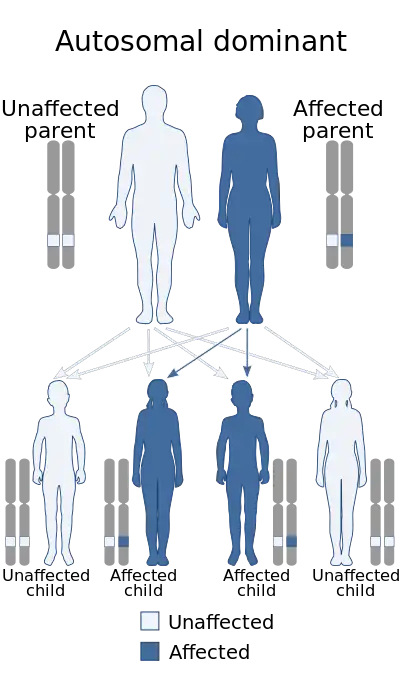PLAID syndrome
PLAID syndrome is an inherited condition characterised by antibody deficiency and immune dysregulation, first described in 2012. The name is an acronym of "PLCG2-associated antibody deficiency and immune dysregulation". It is characterised by cold-induced urticaria, autoimmunity, atopy and humoral immune deficiency.[1]
| PLAID syndrome | |
|---|---|
| Other names | PLCG2-associated antibody deficiency and immune dysregulation |
 | |
| PLAID syndrome is inherited via an autosomal dominant manner | |
| Specialty | Dermatology |
Presentation
This condition is characterised by cold induced urticaria, autoimmunity, atopy and humoral immune deficiency.[2] The humeral immune deficiency results in recurrent bronchopulmonary infections. Cutaneous granulomas may also occur.
The urticaria usually appears within 12 months of birth but may appear immediately after birth.[3] Swallowing cold materials may be associated with discomfort.
Autoimmune thyroiditis and vitiligo may occur. Recurrent infections may lead to the development of bronchiectasis.
Genetics
The syndrome is caused by mutations in the phospholipase C gamma 2 (PLCG2) gene.[4][5] This gene is located on the long arm of chromosome 16 (16q23.3).[6]
The pathogenesis of this condition is not understood. It is however known that phospholipase C gamma is an important signalling mediation for natural killer cells.[7]
Diagnosis
Two thirds of patients have positive anti nuclear antibodies. The IgM levels are usually low and a low IgA is common. There is a poor antibody response to pneumococcal vaccines. The natural killer cells are low or low normal. Switched memory B cells (IgM, IgD, CD27+) may be present in the blood.
Differential diagnosis
Epidemiology
This is considered a rare condition, with 30 patients described in the literature up to 2019.[9]
History
This condition was first described in 2012.[10] The name is an acronym of PLCG2-associated antibody deficiency and immune dysregulation.
References
- Milner, JD (August 2015). "PLAID: a Syndrome of Complex Patterns of Disease and Unique Phenotypes". Journal of Clinical Immunology. 35 (6): 527–30. doi:10.1007/s10875-015-0177-x. PMC 4575258. PMID 26206677.
- Milner JD (2015) PLAID: a syndrome of complex patterns of disease and unique phenotypes. J Clin Immunol 35(6):527-530
- Aderibigbe OM, Priel DAL, Lee C-CR, Ombrello MJ, Prajapati VH, Liang MG, et al (2015) Distinct cutaneous manifestations, autonomous and cold-induced leukocyte activation associated with PLCG2 mutations. JAMA Dermatology
- Zhou Q, Lee GS, Brady J, Datta S, Katan M, Sheikh A, Martins MS, Bunney TD, Santich BH, Moir S, Kuhns DB, Long Priel DA, Ombrello A, Stone D, Ombrello MJ, Khan J, Milner JD, Kastner DL, Aksentijevich I (2012) A hypermorphic missense mutation in PLCG2, encoding phospholipase Cγ2, causes a dominantly inherited autoinflammatory disease with immunodeficiency. Am J Hum Genet 91(4):713-720. doi: 10.1016/j.ajhg.2012.08.006
- Yu P, Constien R, Dear N, Katan M, Hanke P, Bunney TD, Kunder S, Quintanilla-Martinez L, Huffstadt U, Schröder A, Jones NP, Peters T, Fuchs H, de Angelis MH, Nehls M, Grosse J, Wabnitz P, Meyer TP, Yasuda K, Schiemann M, Schneider-Fresenius C, Jagla W, Russ A, Popp A, Josephs M, Marquardt A, Laufs J, Schmittwolf C, Wagner H, Pfeffer K, Mudde GC (2005) Autoimmunity and inflammation due to a gain-of-function mutation in phospholipase C gamma 2 that specifically increases external Ca2+ entry. Immunity 22(4):451-465.
- Hernandez D, Egan SE, Yulug IG, Fisher EM (1994) Mapping the gene that encodes phosphatidylinositol-specific phospholipase C-gamma 2 in the human and the mouse. Genomics 23(2):504-507
- Tassi I, Presti R, Kim S, Yokoyama WM, Gilfillan S, Colonna M (2005) Phospholipase C-gamma 2 is a critical signaling mediator for murine NK cell activating receptors. J Immunol 175(2):749-754
- Kanazawa, N (February 2014). "Hereditary disorders presenting with urticaria". Immunology and Allergy Clinics of North America. 34 (1): 169–79. doi:10.1016/j.iac.2013.08.001. PMID 24262697.
- Neves JF, Doffinger R, Barcena-Morales G, Martins C, Papapietro O, Plagnol V, Curtis J, Martins M, Kumararatne D, Cordeiro AI, Neves C, Borrego LM, Katan M, Nejentsev S (2019) Novel PLCG2 mutation in a patient With APLAID and cutis laxa. Front Immunol 9:2863
- Ombrello MJ, Remmers EF, Sun G, et al (2012) Cold urticaria, immunodeficiency, and autoimmunity related to PLCG2 deletions. N Engl J Med 366(4):330–338
Further reading
- Ombrello, MJ; et al. (26 January 2012). "Cold urticaria, immunodeficiency, and autoimmunity related to PLCG2 deletions". The New England Journal of Medicine. 366 (4): 330–8. doi:10.1056/NEJMoa1102140. PMC 3298368. PMID 22236196.